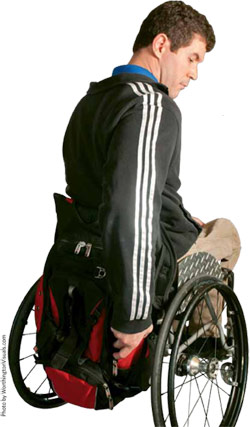
If you like the idea of a pack made especially for wheelchairs, some users swear by the TiLite bag.
By Kate Matelan
Let’s face it — our wheelchair bags don’t carry just a wallet. We tote around our personal and medical lives. Between rubbing on wheels and solid chair frames and getting caught on every other wheelchair part imaginable, our carry-alls take a pretty good beating. Finding one that also fits on your chair without falling off and opens and closes appropriately makes for a long list of demands.
And although those “wheelchair bags” from chair manufacturers might be designed to fit over the back of your chair, they aren’t winning any style points in my book. Believe me, other options do exist! What you ought to have is a swanky, sporty or funky bag that’ll make a statement yet still be functional.
Style
You’ve got a lot of options — backpack, satchel, drawstring, messenger, tote, etc. They all have their pros and cons, but none stick out as an absolute “no.” You do, however, need to see how they fit on your chair and figure out what’s the easiest style to get on and off throughout the day. A major style decider is how each opens up and allows you to access the interior of the bag. For example, backpacks unzip completely, allowing you to reach in at any angle, while a messenger only allows access from the top. You’ll want a style that matches how you or a companion can best get to whatever is inside. Plus, the type of bag needs to fit your style — it’s more than a bag, it’s something that screams, “This is all me!”

Gabe Gerbic likes Swiss Army backpacks, which have lots of pockets and pouches.
Size
Your choice of size is dependent upon what you intend to pack and the style of your chair. You want enough room to get your goods in and out, but not so much that it creates a black hole for your meds or car keys.
The biggest factor is the configuration of your chair — be sure the size of the bag fits on your ride snugly without inhibiting any wheeling or getting prodded by wheelchair parts. You want it to be secure so a) you don’t innocently lose your belongings and b) someone can’t snatch it off the back of your chair. Move around with the bag to see if it drags on the ground or gets twisted when you push or pop a wheelie.
Fabric
Durability and wash-ability are the keys to any good bag fabric. I use my bags to carry around my personal life and my cath life, so there are a lot of fluids involved. If my lubricant explodes, I don’t want to have to dry clean my bag and wonder if that spot might be there long-term.
Avoid leather and suede since those textiles probably won’t handle a lot of chair rubbing, spills or weather elements as well as other fabrics.
A nylon backpack works best. It’s durable and washable, so you can count on it to maintain its strength and be cleaned in a flash. If you’re caught in wet weather, a nylon bag can dry off quickly. Another option is a cloth-like tote for dependability, but be cautious of a soaking rain, since moisture might linger. No matter the fabric, make sure the straps on your bag are sturdy and sewn in well; they’ll take a lot of stress hanging on your chair.
Color
Darker colors rule when it comes to masking the wear and tear your bag will endure from wheeling and being dropped or dragged on all kinds of surfaces. However, solids are a bit of a bland option. To upgrade something plain, add buttons, screen printing, scarves, etc. for personal flair, but don’t go overboard or start bedazzling your bag to no end. Too many extras look tacky and can tangle up in your chair.
If you want to ditch the solids, opt for a printed bag that incorporates bold colors with a darker undertone — think a pattern of orange, green and tan with a brown undertone. The brown will keep your backpack from looking too dirty or scuffed while still including that pop of color. Steer clear of prints that are too cutesy or tough since you might have it on your chair when wheeling into an important meeting.
Closures
Zippers, snaps and Velcro are all typical bag closures. You can always play around with key chains and other key rings to make zippers more convenient. Be sure that the closure actually closes your bag and protects all valuables. Since it’ll be hanging on the back of your chair, you want to make sure someone can’t unknowingly slip into your bag and that something can’t silently tumble out.
Kate’s Top 5 Tips
- Consider the weight. A full bag might throw off the balance of your chair or add excessive weight to your wheeling.
- Add some security. If you’re rocking handlebars, buy some rubber chair leg protectors and squeeze them on the end of your bars to keep your bag in place.
- Cross the straps. Try crisscrossing the straps to make a tote fit on the back of your chair without too much bulge.
- Leave your name and number. Keep a business card or note in your bag in case you accidently lose it.
- Go for the extras. Pockets on the inside and out are great for cell phones and other items you need readily accessible.
